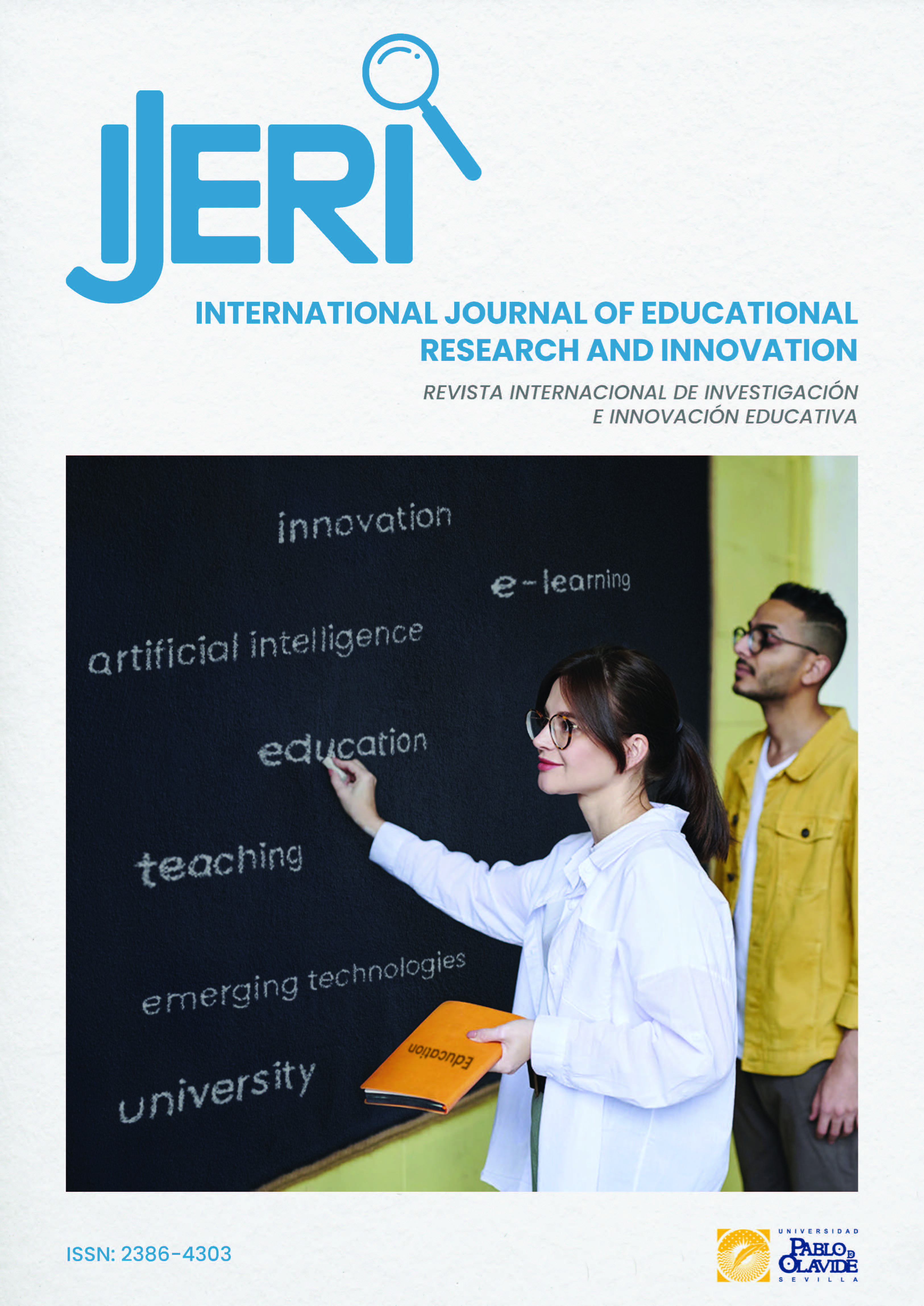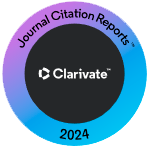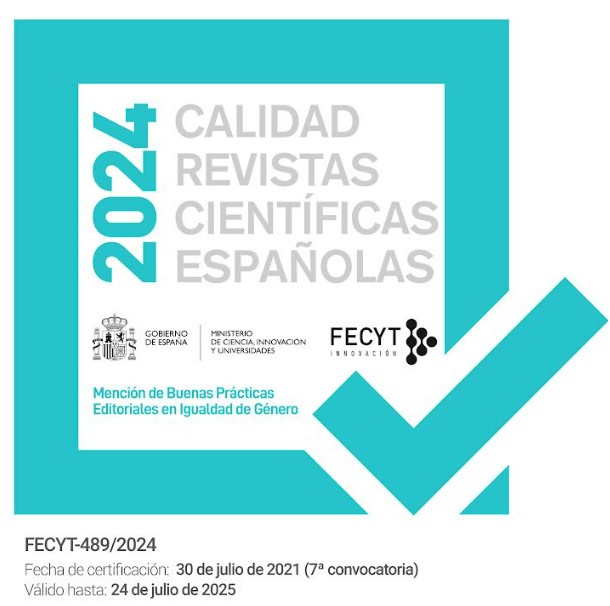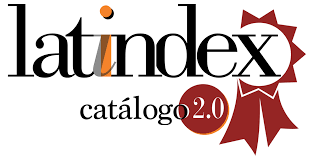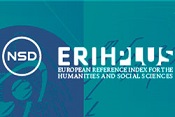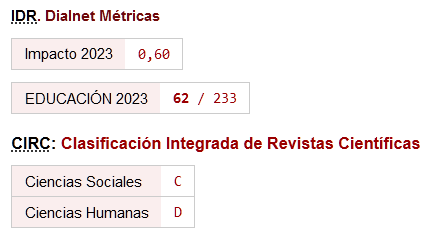Usabilidad de un recurso de realidad virtual para la enseñanza de osciloscopios
valoración de expertos
DOI:
https://doi.org/10.46661/ijeri.10917Palabras clave:
Usabilidad, aceptabilidad, ambiente virtual, SUS, valoración de expertosResumen
La realidad virtual forma parte del conjunto de tecnologías hápticas que permiten al usuario interactuar con un escenario artificial, distintos al mundo real, pero muy parecido a él. Dentro del campo de la educación, promueve aprendizajes activos y dinámicos, con experiencias inmersivas. El objetivo de este estudio fue evaluar la usabilidad de un objeto en formato de RV para la enseñanza del osciloscopio. Se creó un ambiente virtual de un laboratorio de Física, versión 1.0. La metodología tiene un enfoque cuantitativo, de corte descriptivo. Los datos se recogieron mediante la escala de usabilidad del sistema (SUS, por sus siglas en inglés), diseñada por Brooke (1996), que fue aplicada a expertos, tanto en el área de tecnología como de Física, para un total de 42 participantes. Se obtuvieron los índices de Alfa de Cronbach y Omega de McDonald con valores de 0.924 y 0.901, respectivamente. Los resultados obtenidos reflejan que el recurso elaborado en formato de Realidad Virtual (RV), obtuvo una valoración de 72.58, para un percentil entre 65 y 69, dentro de un abanico de 500 estudios realizados previamente, por diversos autores, en lo referente a la SUS. Esto indica que el objeto creado tiene un buen rango de aceptación, siendo valorado como muy bueno y adecuado para su utilización en la enseñanza.
Descargas
Citas
Adrogué, C., Daura, F., Del Rio, D., & Favarel, I. (2020). Influence of learning strategies and skills on academic performance. Revista Educación, 45(1), 4-19. https://doi.org/10.15517/revedu.v45i1.41065
Aguilar, S. (2020). A research-based approach for evaluating resources for transitioning to teaching online. Information and Learning Sciences, 121(5), 301-310. https://doi.org/10.1108/ILS-04-2020-0072
Ampuan, A., & Deleña, R. (2024, 29–30 January). A Quantitative Evaluation of Online Appointment System at Mindanao State University–Main Campus: Employing the System Usability Scale (SUS) and Technology Acceptance Model (TAM) [Paper presentation]. 2024 3rd International Conference on Digital Transformation and Applications (ICDXA), Kuala Lumpur, Malaysia. https://doi.org/10.1109/ICDXA61007.2024.10470770
Ausín-Villaverde, V., Rodríguez Cano, S., Delgado Benito, V., & Toma, R. B. (2023). Evaluation of an augmented reality APP for children with dyslexia: a pilot study: [Evaluation of an augmented reality APP for children with dyslexia: a pilot study]. Pixel-bit. Journal of Media and Education, 66(0), 87–111. https://doi.org/10.12795/pixelbit.95632
Awang, L., Yusop, F., & Danaee, M. (2024). Insights on usability testing: The effectiveness of an adaptive e-learning system for secondary school mathematics. International Electronic Journal of Mathematics Education, 19(3), 07–82. https://doi.org/10.29333/iejme/14621
Bala, R., & Gupta, P. (2024). Virtual Reality in Education. In R. Malik, A. Sharma, P. Chaudhary (Eds.), Transforming Education with Virtual Reality (pp. 165–180). John Wiley & Sons, Ltd. https://doi.org/10.1002/9781394200498.ch10
Bangor, A., Kortum, P., & Miller, J. (2009). Determining what individual SUS scores mean: Adding an adjective rating scale. Journal of Usability Studies, 4(3), 114–123. https://uxpajournal.org/wp-content/uploads/sites/7/pdf/JUS_Bangor_May2009.pdf
Bansal, M., Arora, R., & Bharti, R. (2023). A taxonomical review of developments in digital storage oscilloscope (DSO). AIP Conference Proceedings, 2796(1), 18–81. https://doi.org/10.1063/5.0149169
Bengsch, G. (2024). Redefining Traditional Education: The Integration of Machine Learning in the Contemporary Language Education Classroom. In F. Pan (Ed.), AI in Language Teaching, Learning, and Assessment (pp. 195–221). IGI Global. https://doi.org/10.4018/979-8-3693-0872-1.ch010
Bergen, N., & Labont ́e, R. (2020). Everything Is perfect, and we have no problems: Detecting and limiting social desirability bias in qualitative research. Qualitative Health Research, 30(5), 783–792. https://doi.org/10.1177/1049732319889354
Brooke, J. (1996). SUS—A Quick and Dirty Usability Scale. In P. W. Jordan, B. Thomas, B. A. Weerdmeester, & I. L. McClelland (Eds.), Usability Evaluation in Industry (pp. 189-194). Taylor & Francis.
Brooke, J. (2013). SUS: A retrospective. Journal of Usability Studies, 8(2), 29–40. https://www.researchgate.net/publication/285811057_SUS_a_retrospective
Bucăţa, G., & Tileagă, C. (2024). Digital Renaissance in Education: Unveiling the Transformative Potential of Digitization in Educational Institutions. Land Forces Academy Review, 29(1), 20–37. https://doi.org/10.2478/raft-2024-0003
Cabero, J., & Barroso, J. (2013). The use of expert judgment for ICT assessment: the coefficient of expert competence. Embroidery. Journal of Pedagogy, 65(2), 25-38. https://doi.org/10.13042/brp.2013.65202
Cabero-Almenara, J., & Marín-Díaz, V. (2012). ICT training of university teachers in a personal learning environment. Project DIPRO 2.0. New Approaches in Educational Research, 1(1), 2-6. https://doi.org/10.7821/naer.1.1.2-6
Cabero-Almenara, J., Barroso-Osuna, J., & Palacios-Rodríguez, A. (2021). Digital competences of educators in Health Sciences: Their relationship with some variables. Medical Education, 22(2), 94-98. https://doi.org/10.1016/j.edumed.2020.11.014
Campo-Prieto, P., Cancela Carral, J. M., Machado de Oliveira, I., & Rodríguez-Fuentes, G. (2020). Immersive Virtual Reality in older people: a case study (case study). Challenges, 39(0). 101–105. https://doi.org/10.47197/retos.v0i39.78195
Carulli, M., Rossoni, M., Spadoni, E., Dozio, N., Giussani, R., Ferrise, F., & Bordegoni, M. (2024). A Case Study on Digital Training: Benefits and Unexplored Opportunities. Journal of Computing and Information Science in Engineering, 24(05), 25–50. https://doi.org/10.1115/1.4064797
Castilla, D., Jaen, I., Suso-Ribera, C., Garcia-Soriano, G., Zaragoza, I., Breton-Lopez, J., Mira, A., Diaz-Garcia, A., & Garcia-Palacios, A. (2023). Psychometric Properties of the Spanish Full and Short Forms of the System Usability Scale (SUS): Detecting the Effect of Negatively Worded Items. International Journal of Human–Computer Interaction, 0(0), 1–7. https://doi.org/10.1080/10447318.2023.2209840
Cheah, W., Mat, N. Thwe, M., & Amin, A. (2022). Mobile Technology in Medicine: Development and Validation of an Adapted System Usability Scale (SUS). Questionnaire and Modified Technology Acceptance Model (TAM) to Evaluate User Experience and Acceptability of a Mobile Application in MRI Safety Screening. Indian Journal or Radiology and Imaging, 33(1), 37–45. https://doi.org/10.1055/s-0042-1758198
Cruz Ramírez, M., & Martínez, C. (2020). Origin and development of an index of expert competence: The coefficient k. Latin American Journal of Social Research Methodology, 1(19), 40-56.
Daling, L. M., & Schlittmeier, S. J. (2024). Effects of Augmented Reality-, Virtual Reality-, and Mixed Reality–Based Training on Objective Performance Measures and Subjective Evaluations in Manual Assembly Tasks: A Scoping Review. Human Factors, 66(2), 589–626. https://doi.org/10.1177/00187208221105135
De Felice, F., Petrillo, A., Iovine, G., Salzano, C., & Baffo, I. (2023). How Does the Metaverse Shape Education? A Systematic Literature Review. Applied Sciences, 13(9), 9–21. https://doi.org/10.3390/app13095682
Ensink, C. J., Keijsers, N. L. W., & Groen, B. E. (2024). Translation and validation of the System Usability Scale to a Dutch version: D-SUS. Disability and Rehabilitation, 46(2), 395–400. https://doi.org/10.1080/09638288.2022.2160837
Fink, M., Eisenlauer, V. & Ertl, B. (2023). What variables are connected with system usability and satisfaction? Computers & Education: X Reality, 3, 100043. https://doi.org/10.1016/j.cexr.2023.100043
Galuh, F., Fadila, G. and Adi, N. (2021). Evaluasi Usability Website Shopee Menggunakan System Usability Scale (SUS). Journal of Applied Informatics and Computing (JAIC), 5(2), 146–150. https://doi.org/10.30871/jaic.v5i2.3293
Gao, R., Lee, P., Ravi, A., Ren, C., Dickerson, C., & Tung, J. (2024). Hybrid Soft-Rigid Active Prosthetics Laboratory Exercise for Hands-On Biomechanical and Biomedical Engineering Education. Journal of Biomechanical Engineering, 29(1), 1–55. https://doi.org/10.1115/1.4065008
Gimeno, S. (2018). Five ways to interpret a SUS. Torresburriel. https://torresburriel.com/weblog/cinco-formas-de-interpretar-un-sus/
Herres, D. (2020). Acquiring, Displaying, and Measuring Digital Signals in an Oscilloscope. In D. Herres (Ed.), Oscilloscopes: A Manual for Students, Engineers, and Scientists (pp. 155–180). Springer International Publishing. https://doi.org/10.1007/978-3-030-53885-9_6
Hong, J., Chan, H., Teng, Y., Tai, K., & Lin, C. (2023). VR training program for fire escape: Learning progress predicted by the perception of fire presence, VR operational frustration, and gameplay self-efficacy. Computers & Education: X Reality, 3, 100029. https://doi.org/10.1016/j.cexr.2023.100029
Hsu, T., Huang, H., Hwang, G., & Chen, M. (2023). Effects of Incorporating an Expert Decision-making Mechanism into Chatbots on Students’ Achievement, Enjoyment, and Anxiety. Educational Technology & Society, 26(1), 218–231. https://www.jstor.org/stable/48707978
Huang, Y., Hu, Y., Chan, U., Lai, P., Sun, Y., Dai, J., Cheng, X., & Yang, X. (2023). Student perceptions toward virtual reality training in dental implant education. PeerJ, 11(1), 14–57. https://doi.org/10.7717/peerj.14857
Izquierdo-Álvarez, V. (2024). Integration of Information and Communication Technologies Education for the Deaf. In M. Khaldi (Eds.), Technological Tools for Innovative Teaching (pp. 103–120), IGI Global. https://doi.org/10.4018/979-8-3693-3132-3.ch006
Kartiko, I., Kavakli, M. & Cheng, K. (2010). Learning science in a virtual reality application: The impacts of animated-virtual actors’ visual complexity. Computer & Education, 55(0), 881–891. https://doi.org/10.1016/j.compedu.2010.03.019
Koolivand, H., Shooreshi, M. M., Safari-Faramani, R., Borji, M., Mansoory, M., Moradpoor, H., Bahrami, M., & Azizi, S. (2024). Comparison of the effectiveness of virtual reality-based education and conventional teaching methods in dental education: A systematic review. BMC Medical Education, 24(1), 18–34. https://doi.org/10.1186/s12909-023-04954-2
Korlat, S., Kollmayer, M., Haider, C., Hlavacs, H., Martinek, D., Pazour, P. & Spiel, C. (2024). PhyLab – a virtual reality laboratory for experiments in Physics: a pilot study on intervention effectiveness and gender differences. Frontiers in Psychology, 15(0), 1-13. https://doi.org/10.3389/fpsyg.2024.1284597
Landeta, J. (2002). The Delphi method: a technique for forecasting the future. Oh, Ariel.
Levitt, H. M. (2021). Qualitative generalization, not to the population but to the phenomenon: Reconceptualizing variation in qualitative research. Qualitative Psychology, 8(1), 95–110. https://doi.org/10.1037/qup0000184
Lewis, J. (2018) The System of Usability Scale: Past, Present, and Future. International Journal of Human-Computer Interaction, 34(7), 577–590. https://doi.org/10.1080/10447318.2018.1455307
Lewis, J. R., and Sauro, J. (2009). The Factor Structure of the System Usability Scale. Lecture Notes in Computer Science (Including Subseries Lecture Notes in Artificial Intelligence and Lecture Notes in Bioinformatics), 5619(0), 94–103. https://doi.org/10.1007/978-3-642-02806-9_12
Lirola Sabater, F., & Pérez Garcias, A. (2020). The perceived usability of distance vocational training teachers in the Balearic Islands. Pixel-Bit, 59(1), 147–183. https://doi.org/10.12795/pixelbit.76299
López-Belmonte, J., Duo-Terrón, P., Moreno-Guerrero, A.-J., & Marín-Marín, J.-A. (2024). Effects of augmented and virtual reality on students with ASD (ASD). Pixel-bit. Journal of Media and Education, 70(0), 7–23. https://doi.org/10.12795/pixelbit.103789
López-Meneses, E., & Fernández-Cerero, J. (2020). Information and Communication Technologies and functional diversity: knowledge and training of teachers in Navarra. IJERI: International Journal of Educational Research and Innovation, 14, 59–75. https://doi.org/10.46661/ijeri.4407
Ma, J., Wang, Y., Joshi, S., Wang, H., Young, C., Pervez, A., Qu, Y., & Washburn, S. (2024). Using immersive virtual reality technology to enhance nursing education: A comparative pilot study to understand efficacy and effectiveness. Applied Ergonomics, 11(5), 104–159. https://doi.org/10.1016/j.apergo.2023.104159
Malla, F. & Zabala, I. (1978). Forecasting the future in the company (III): the Delphi method. Business Studies, 39,13–24.
Marco-Ahulló, A., Montesinos-Magraner, L., Segura-Navarro, X., Crespo-Rivero, T., González, M. & García-Masso, X. (2022). Design and usability of ParaSportAPP: an mHealth designed to promote physical activity in people with spinal cord injury. Andalusian Journal of Sports Medicine. 15(2), 65–71, https://ws208.juntadeandalucia.es/ojs/index.php/ramd/article/view/921/1326.
Marín-Díaz, V., Sampedro, B. E., & Vega Gea, E. (2022). Promoting learning through use of 360º videos. Innoeduca. International Journal of Technology and Educational Innovation, 8(2), 138–151. https://doi.org/10.24310/innoeduca.2022.v8i2.15120
Marougkas, A., Troussas, C., Krouska, A., & Sgouropoulou, C. (2024). How personalized and effective is immersive virtual reality in education? A systematic literature review for the last decade. Multimedia Tools and Applications, 83(6), 18185–18233. https://doi.org/10.1007/s11042-023-15986-7
Martínez, E., Nadina, C., Sagaró, N, Urbina, O. & Martínez, I. (2018). Identification of the specific competencies of nurses in the care of the neonate in severe condition. Medisan, 22(2).1–84. http://scielo.sld.cu/scielo.php?script=sci_arttext&pid=S1029-30192018000200009&lng=es&nrm=iso
Martins, N., Barros, L., Henriques, M., Silva, S., & Ferreira, I. (2015). Activity of phenolic compounds from plant origin against Candida species. Industrial Crops and Products, 74(0), 648–670. https://doi.org/10.1016/j.indcrop.2015.05.067
Mata, F.J.& Hernández-Ruíz, I. (2019). Usability assessment for an e-commerce site: Development of a methodology and its application to the site crgourmetcoffee.com. In Y. Morales-López (Ed.), Memoirs of the First International Congress of Exact and Natural Sciences of the National University, Costa Rica, 2019 (pp. 1-10). Heredia: Universidad Nacional. https://doi.org/10.15359/cicen.1.9
Mayer, J. (2002). Multimedia learning. Psychology of Learning and Motivation, 42, 85–139. https://doi.org/10.1016/S0079-7421(02)80005-6
Mayer, R. E. (2021). Multimedia learning (3rd ed). Cambridge University Press. https://doi.org/10.1017/9781316941355
Menjívar-Valencia, E., Sánchez-Rivas, E., Ruiz-Palmero, J., & Guillén-Gámez, F. D. (2022). Percepciones de estudiantes universitarios sobre la realidad virtual como recurso didáctico: un estudio preexperimental con un grupo de control y experimental. IJERI: International Journal of Educational Research and Innovation, (17), 152–171. https://doi.org/10.46661/ijeri.5904
Mukasheva, M., Kornilov, I., Beisembayev, G., Soroko, N., Sarsimbayeva, S., & Omirzakova, A. (2023). Contextual structure as an approach to the study of virtual reality learning environment. Cogent Education, 10(1), 16–57. https://doi.org/10.1080/2331186X.2023.2165788
Mulder, M., Buchner, J., & Kerres, M. (2020). A Framework for the Use of Immersive Virtual Reality in Learning Environments. International Journal of Emerging Technologies in Learning (iJET), 15(24), 208–224. https://doi.org/10.3991/ijet.v15i24.16615
Nishchyk, A., Sanderson, N., & Chen, W. (2024). Elderly-centered usability heuristics for augmented reality design and development. Universal Access in the Information Society, 1(1), 1–21. https://doi.org/10.1007/s10209-023-01084-w
O'Dwyer, L. & Bernauer, J. (2014). Quantitative research for the qualitative researcher. Sage. https://doi.org/10.4135/9781506335674
Ong, A. K. S., Prasetyo, Y. T., Robas, K. P. E., Persada, S. F., Nadlifatin, R., Matillano, J. S. A., Macababbad, D. C. B., Pabustan, J. R., & Taningco, K. A. C. (2023). Determination of Factors Influencing the Behavioral Intention to Play Mobile Legends: Bang-Bang during the COVID-19 Pandemic: Integrating UTAUT2 and System Usability Scale for a Sustainable E-Sport Business. Sustainability, 15(4), 1–26. https://doi.org/10.3390/su15043170
Palacios-Rodríguez, A., Cabero-Almenara, J., & Serrano-Hidalgo, M. (2024). Educación Médica y Carga Cognitiva: Estudio de la Interacción con Objetos de Aprendizaje en Realidad Virtual y Vídeo 360º. Revista de Educación a Distancia (RED), 24(79). https://doi.org/10.6018/red.582741
Pavuluri, A., Chaitanya, S. N. V. S. K., Nalathoti, V., Jangam, V., & Adimulam, N. (2023). Portable Digital Oscilloscope using Arduino. 2023 International Conference on Inventive Computation Technologies (ICICT), 0(0), 1361–1366. https://doi.org/10.1109/ICICT57646.2023.10134297
Pedram, S., Kennedy, G., & Sanzone, S. (2024). Assessing the validity of VR as a training tool for medical students. Virtual Reality, 28(1), 15-35. https://doi.org/10.1007/s10055-023-00912-x
Pietrzak, P., Pietrzak, P., & Wolkiewicz, M. (2024). Microcontroller-Based Embedded System for the Diagnosis of Stator Winding Faults and Unbalanced Supply Voltage of the Induction Motors. Energies, 17(2), 40–55. https://doi.org/10.3390/en17020387
Pincay Ponce, J., Tapia, J. S. H., & Muentes, W. R. D. (2021). The usability and differential scale of emotions in Android apps. A case study. Mikarimin. Multidisciplinary Scientific Journal, 7(1), 79-86. https://revista.uniandes.edu.ec/ojs/index.php/mikarimin/article/view/2246
Prasetya, L., & Hidayati, Y. (2024). Implementation of augmented reality application in learning mathematics of elementary school. AIP Conference Proceedings, 2926(1), 20–64. https://doi.org/10.1063/5.0185227
Purwaningsih, E., Muslikh, M., Suhaeri, S., & Basrowi, B. (2024). Utilizing blockchain technology in enhancing supply chain efficiency and export performance, and its implications on the financial performance of SMEs. Uncertain Supply Chain Management, 12(1), 449–460. https://doi.org/10.5267/j.uscm.2023.9.007
Rani, M. (2024). Impact of Virtual Reality on Immersive Education. In R. Malik, A. Sharma, P. Chaudhary, (eds.), Transforming Education with Virtual Reality (pp. 101–125). John Wiley & Sons, Ltd. https://doi.org/10.1002/9781394200498.ch7
Robles, K., Gutiérrez, M., Castillo, E., & Saldaña, R. (2016). International Organization for Standardization (ISO). Education and Health Scientific Bulletin Institute of Health Sciences Universidad Autónoma del Estado de Hidalgo, 4(8), 18-26. https://doi.org/10.29057/icsa.v4i8.277
Rodríguez-López, B. (2023). Ethics of Virtual Reality. In: F. Lara, J. Deckers, (eds) Ethics of Artificial Intelligence. The International Library of Ethics, Law and Technology (pp. 1–107). Springer, Cham. https://doi.org/10.1007/978-3-031-48135-2_6
Samala, A. D., Ricci, M., Angel Rueda, C. J., Bojic, L., Ranuharja, F., & Agustiarmi, W. (2024). Exploring Campus through Web-Based Immersive Adventures Using Virtual Reality Photography: A Low-Cost Virtual Tour Experience. International Journal of Online & Biomedical Engineering, 20(1), 104–127. https://doi.org/10.3991/ijoe.v20i01.44339
Santosa, M., & Banjar, I. (2024). Animals of Nusantara: Virtual Reality-Based English Learning Materials for Secondary Students. Nusantara Science and Technology Proceedings, 2024(38), 9–22. https://doi.org/10.11594/nstp.2024.3802
Satu, P., Jari, L., Hanna, K., Tomi, P., Marja, L., & Tuisku-Tuuli, S. (2024). Virtual-Reality training solutions for nuclear power plant field operators: A scoping review. Progress in Nuclear Energy, 169(0), 104–125. https://doi.org/10.1016/j.pnucene.2024.105104
Sauro, J., & Lewis, J. (2012). Quantifying the user experience: Practical statistics for user research. Elsevier/Morgan Kaufmann. https://doi.org/10.1016/B978-0-12-384968-7.00002-3
Segura, M. & Osorio, R. (2021). Usability in Accessible and Inclusive Multi-Scenario Immersive Virtual Reality Applications: Case Study. Investigación e Innovación en Ingenierías, 9 (3), 82-92, 2021. https://doi.org/10.17081/invinno.9.3.5563
Shaban, A., Saraeva, A., Rose, S., & Clark, M. (2024). The invisible hand of touch: Testing a tactile sensation-choice satisfaction model in online shopping. Journal of Sensory Studies, 39(1), 12–37. https://doi.org/10.1111/joss.12897
Shadiev, R., Yi, S., & Altinay, F. (2024). Cultivating self-directed learning abilities in K-12 students through immersive online virtual tours. Interactive Learning Environments, 0(0), 1–26. https://doi.org/10.1080/10494820.2024.2312923
Sharma, G., Kraus, S., Liguori, E., Bamel, U., & Chopra, R. (2024). Entrepreneurial challenges of COVID-19: Re-thinking entrepreneurship after the crisis. Journal of Small Business Management, 62(2), 824–846. https://doi.org/10.1080/00472778.2022.2089676
Shu, S., Qian, J., Gong, W., Yang, Z., & Pi, K. (2023). Non-Probabilistic Reliability Analysis of Slopes Based on a Multidimensional Parallelepiped Model. Applied Sciences, 13(17), 1–15. https://doi.org/10.3390/app13179874
Silva, C. & Turrini, R. (2019). Development of an educational mobile application for patients submitted to orthognathic surgery. Magazine. Latin American. Enfermagem, 27:e3143. https://doi.org/10.1590/1518-8345.2904.3143
Sousa, C. S., & Turrini, R. N. T. (2019). Development of an educational mobile application for patients submitted to orthognathic surgery. Revista Latino-Americana de Enfermagem, 27(0), 31-43. https://doi.org/10.1590/1518-8345.2904.3143
Sudharson, D., Malik, R., Sathya, R., Vaishali, V., Balavedhaa, S., & Gautham, S. (2024). A Novel Adaptive Framework for Immersive Learning Using VR in Education. In R. Malik, A. Sharma, P. Chaudhary (Eds), Transforming Education with Virtual Reality (pp. 1–26). John Wiley & Sons, Ltd. https://doi.org/10.1002/9781394200498.ch1
Sychev, S., & Batako, A. (2024). A Study of Sliding Friction Using an Acoustic Emission and Wavelet-Based Energy Approach. Machines, 12(4), 1–15. https://doi.org/10.3390/machines12040265
Vlachogianni, P. & Tselios, N. (2022). Perceived usability evaluation of educational technology using the System Usability Scale (SUS): A systematic review. Journal of Research on Technology in Education, 54(3), 392–409. https://doi.org/10.1080/15391523.2020.1867938
Wang, Q., & Li, Y. (2024). How virtual reality, augmented reality and mixed reality facilitate teacher education: A systematic review. Journal of Computer Assisted Learning, 40(3), 1276–1294. https://doi.org/10.1111/jcal.12949
Wang, X., Chou, M., Lai, X., Tang, J., Chen, J., Kong, W. K., Chi, H., & Yam, M. (2024). Examining the Effects of an Immersive Learning Environment in Tertiary AEC Education: CAVE-VR System for Students’ Perception and Technology Acceptance. Journal of Civil Engineering Education, 150(2), 05–23. https://doi.org/10.1061/JCEECD.EIENG-1995
Wangb, Y., Chen, L., & Han, J. (2024). Exploring factors influencing students’ willingness to use translation technology. Education and Information Technologies, 29(3), 3047–3073. https://doi.org/10.1007/s10639-024-12511-7
Weingärtner Reis, I., Estevão Romeiro, A., Henrique Berg, C., & Ribas Ulbricht, V. (2024). Sociodigital experiences and creativity in the metaverse: An integrative review. Heliyon, 10(7), 29–47. https://doi.org/10.1016/j.heliyon.2024.e29047
Welsandt, N., Fortunati, F., Winther, E., & Abs, H. (2024). Constructing and validating authentic assessments: The case of a new technology-based assessment of economic literacy. Empirical Research in Vocational Education and Training, 16(1), 4–15. https://doi.org/10.1186/s40461-024-00158-0
Witkin, B. & Altschuld, J. W. (1995). Planning and conducting needs assessment: A practical guide. Oh, Sage.
Yang, T., Yang, Y., Huang, C. (2024). Virtual Reality to Teaching the Law of Conservation of Energy in Physics. In: J. Hung, N. Yen, J. Chang, (eds) Frontier Computing on Industrial Application (pp. 60–75). Springer, Singapore. https://doi.org/10.1007/978-981-99-9342-0_16
Yavoruk, O. (2023). The Use of 3D Virtual Tours Technology in Physics Classes for Teaching Physical Quantities. Proceedings of the 2023 4th International Conference on Education Development and Studies, 0(0), 7–11. https://doi.org/10.1145/3591139.3591140
Yuan, Z., Yuan, H., Li, C., Dong, G., Lu, K., Tan, C., Zhou, C., & Zhou, J. (2023). Scaling Relationship on Learning Mathematical Reasoning with Large Language Models (arXiv:2308.01825). arXiv. https://doi.org/10.48550/arXiv.2308.01825
Zou, L., & Liang, T. (2024). Algorithm Optimization of Computer Simulation Vehicle Driving Simulation System Based on Virtual Reality Technology. International Journal of Computational Intelligence Systems, 17(1), 34–62. https://doi.org/10.1007/s44196-024-00426-7
Descargas
Publicado
Cómo citar
Número
Sección
Licencia
Derechos de autor 2024 Jeanette Chaljub Hasbún, Julio Cabero Almenara, Pamela Michel-Acosta, Rafael Bello, Josefina Pepín

Esta obra está bajo una licencia internacional Creative Commons Atribución-NoComercial-SinDerivadas 4.0.

